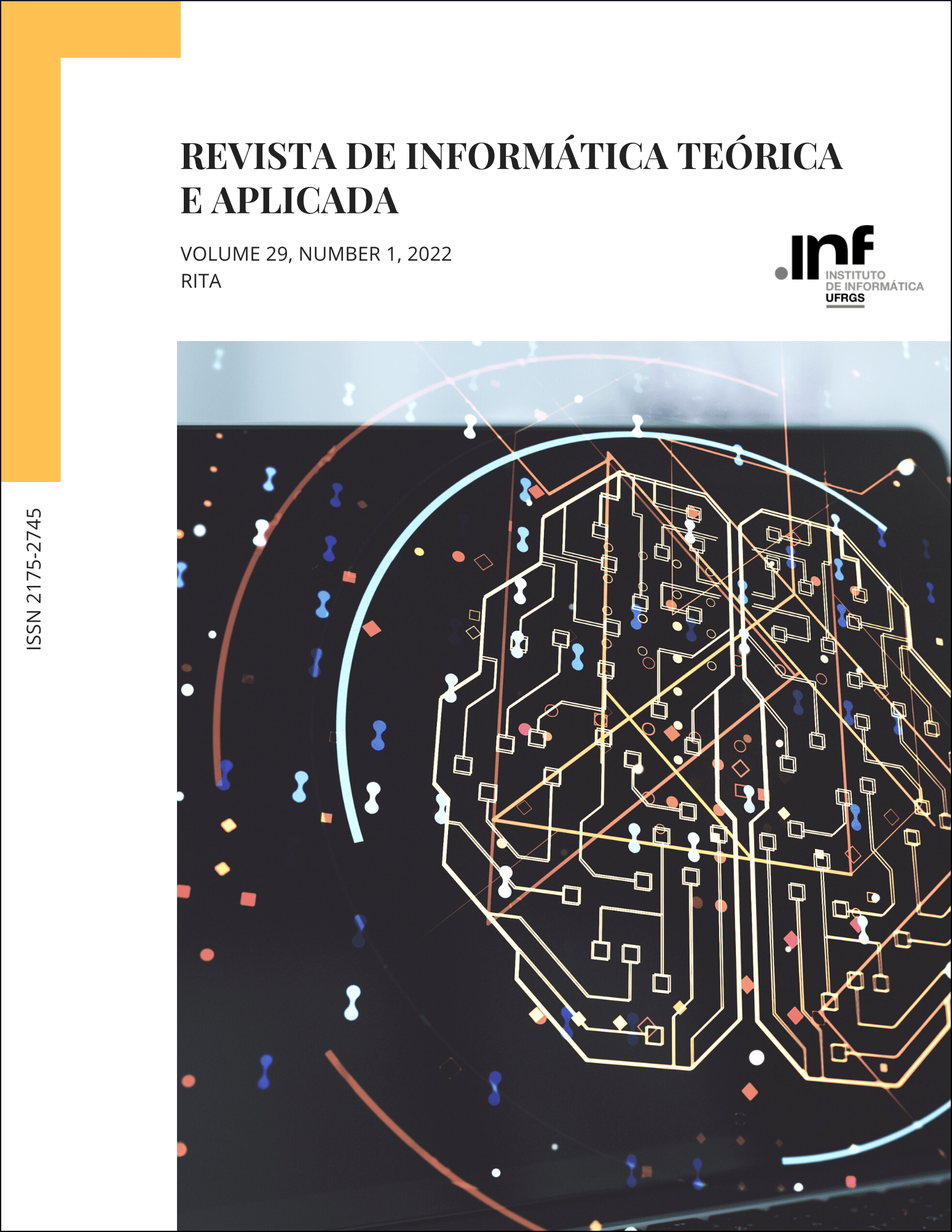Efficient Breast Cancer Classification Using Histopathological Images and a Simple VGG
DOI:
https://doi.org/10.22456/2175-2745.119207Keywords:
breast cancer, machine learning, histopathological images, convolutional neural networkAbstract
Breast cancer is the second most deadly disease worldwide. This severe condition led to 627,000 people dying in 2018. Thus, early detection is critical for improving the patients' lifetime or even curing them. In this context, we can appeal to Medicine 4.0, which exploits machine learning capabilities to obtain a faster and more efficient diagnosis. Therefore, this work aims to apply a simpler convolutional neural network, called VGG-7, for classifying breast cancer in histopathological images. Results have shown that VGG-7 overcomes the performance of VGG-16 and VGG-19, showing an accuracy of 98%, a precision of 99%, a recall of 98%, and an F1 score of 98%.
Downloads
References
INCA.Ministério da Saúde - Instituto Nacional de Câncer, Câncer de mama: vamos falar sobre isso?[S.l.], 2016. Disponível em:〈https://www.inca.gov.br/sites/
ufu.sti.inca.local/files//media/document//cartilha-cancer-de-mama-vamos-falar-sobre-isso2016.pdf,Visiton05-31-2020〉.
AICR.American Institute for Cancer Research, Breast cancer statistics. [S.l.], 2020. Disponível em:〈https://www.wcrf.org/dietandcancer/cancer-trends/breast-cancer-statistics,Visiton05-31-2020〉.
WHO.World Health Organization, Breast cancer. [S.l.], 2020. Disponível em:〈https://www.who.int/cancer/prevention/diagnosis-screening/breast-cancer/en/,Visiton05-31-2020〉.
BELSARE, A.; MUSHRIF, M. Histopathological image analysis using image processing techniques: An overview.SignalImage Process Int J, v. 3, 11 2011.
Titoriya, A.; Sachdeva, S. Breast cancer histopathology image classification using AlexNet. In:4th InternationalConference on Information Systems and Computer Networks (ISCON). [S.l.: s.n.], 2019. p. 708–712.
WOLF, B.; SCHOLZE, C. “medicine 4.0”.Current Directions in Biomedical Engineering, v. 3, n. 2, p. 183–186, 2017.
Spanhol, F. A. et al. A dataset for breast cancer histopathological image classification.IEEE Transactions on BiomedicalEngineering, v. 63, n. 7, p. 1455–1462, 2016.
LECUN, Y. et al. Gradient-based learning applied to document recognition.Proceedings of the IEEE, v. 86, p. 2278 –2324, 12 1998.
Pereira Jr., P. C. et al. Comparison of classical computer vision vs.convolutional neural networks for weed mapping inaerial images.Revista de Informática Teórica e Aplicada (RITA), v. 27, n. 4, p. 11–23, 12 2020.
ZEMOURI, R.; ZERHOUNI, N.; RACOCEANU, D. Deep learning in the biomedical applications: Recent and futurestatus.Applied Sciences, v. 9, n. 8, 2019.
GULSHAN, V. et al. Development and Validation of a Deep Learning Algorithm for Detection of Diabetic Retinopathy inRetinal Fundus Photographs.JAMA, v. 316, n. 22, p. 2402–2410, 2016.
GAYATHRI, S.; GOPI, V. P.; PALANISAMI, P. A lightweight cnn for diabetic retinopathy classification from fundusimages.Biomedical Signal Processing and Control, v. 62, p. 102115, 2020.
SU, Y.; LI, D.; CHEN, X. Lung nodule detection based on faster r-cnn framework.Computer Methods and Programs inBiomedicine, v. 200, p. 105866, 2021.
Spanhol, F. A. et al. Breast cancer histopathological image classification using convolutional neural networks. In:2016International Joint Conference on Neural Networks (IJCNN). [S.l.: s.n.], 2016. p. 2560–2567.
BEJNORDI, B. E. et al. Diagnostic Assessment of Deep Learning Algorithms for Detection of Lymph Node Metastases inWomen With Breast Cancer.JAMA, v. 318, n. 22, p. 2199–2210, 2017.
SILVA, D. C. S. e.; CORTES, O. A. C. On convolutiona neural networks and transfer learning for classifying breast canceron histopahological images using gpu. In:XXVII Brazilian COngress on Biomedical Engineering. [S.l.: s.n.], 2020.
Ismail, N. S.; Sovuthy, C. Breast cancer detection based on deep learning technique. In:2019 International UNIMASSTEM 12th Engineering Conference (EnCon). [S.l.: s.n.], 2019. p. 89–92.
Singh, R. et al. Imbalanced breast cancer classification using transfer learning.IEEE/ACM Transactions on Computational Biology and Bioinformatics, p. 83–93, 2020.
SIMONYAN, K.; ZISSERMAN, A. Very deep convolutional networks for large-scale image recognition. In:InternationalConference on Learning Representations. [S.l.: s.n.], 2015.
SHALLU; MEHRA, R. Breast cancer histology images classification: Training from scratch or transfer learning? ICTExpress, v. 4, n. 4, p. 247–254, 2018.
SAIKIA, A. R. et al. Comparative assessment of CNN architectures for classification of breast fnac images.Tissue andCell, v. 57, p. 8–14, 2019. EM in cell and tissues.
SITAULA, C.; HOSSAIN, M. Attention-based VGG-16 model for covid-19 chest x-ray image classification.AppliedIntelligence, Springer, v. 51, p. 2850–2863, 2020.
KHAMPARIA, A. et al. Diagnosis of breast cancer based on modern mammography using hybrid transfer learning.Multidimensional Systems and Signal Processing, v. 32, p. 747–765, 2021.
II, T. B.Introduction to Deep Learning Using R: a step-by-step guide to learning and implementing Deep LearningModels Using R. [S.l.]: Apress, 2017.
TORREY, L.; SHAVLIK, J. Transfer learning. In: OLIVAS, E. S. et al. (Ed.).Handbook Of Research On MachineLearning Applications and Trends: Algorithms, Methods and Techniques. , Hershey, New York: Information Science Reference,2009. cap. 11, p. 242–264.
RANZATO, M. et al. Unsupervised learning of invariant feature hierarchies with applications to object recognition. In:2007 IEEE Conference on Computer Vision and Pattern Recognition. [S.l.: s.n.], 2007. p. 1–8.
LIN, M.; CHEN, Q.; YAN, S.Network In Network. 2014.
ABADI, M. et al.TensorFlow: Large-Scale Machine Learning on Heterogeneous Systems. 2015. Software available fromtensorflow.org. Disponível em:〈https://www.tensorflow.org/〉.
PEDREGOSA, F. et al. Scikit-learn: Machine learning in Python.Journal of Machine Learning Research, v. 12, p.2825–2830, 2011.
Google.Kaggle platform. [S.l.], 2021. Disponível em:〈https://www.kaggle.com/,Visitedon27-09-2021〉.
KINGMA, D.; BA, J. Adam: A method for stochastic optimization.International Conference on Learning Representations,12 2014.
GLOROT, X.; BENGIO, Y. Understanding the difficulty of training deep feedforward neural networks.Journal ofMachine Learning Research - Proceedings Track, v. 9, p. 249–256, 01 2010.
BEHN, R. Why measure performance? different purposes require different measures.Public Administration Review, v. 63,p. 586 – 606, 09 2003.
SELVARAJU, R. R. et al. Grad-cam: Why did you say that? visual explanations from deep networks via gradient-basedlocalization.CoRR, abs/1610.02391, 2016. Disponível em:〈http://arxiv.org/abs/1610.02391〉.
WOO, S. et al. CBAM: convolutional block attention module.CoRR, abs/1807.06521, 2018. Disponível em:〈http://arxiv.org/abs/1807.06521〉.
NAIR, V.; HINTON, G. Rectified linear units improve restricted boltzmann machines vinod nair. In: . [S.l.: s.n.], 2010.v. 27, p. 807–814.















